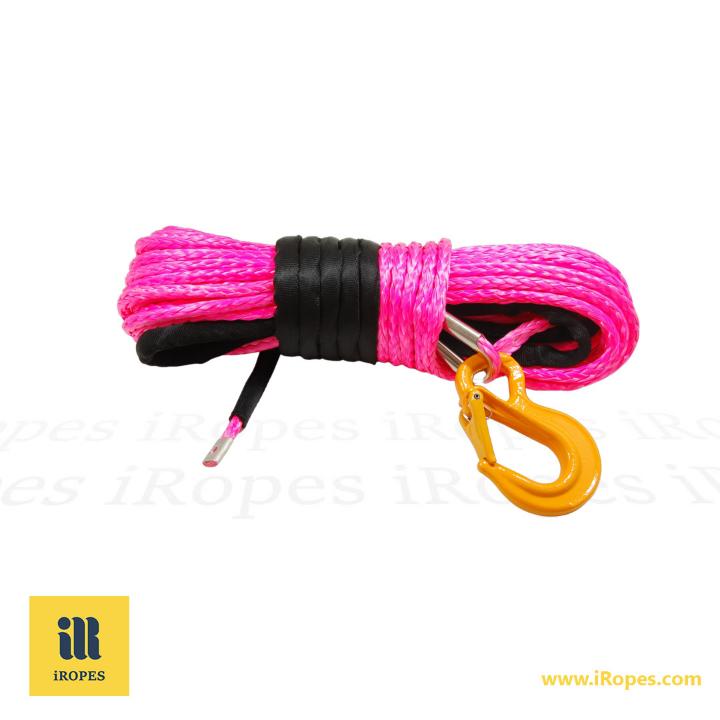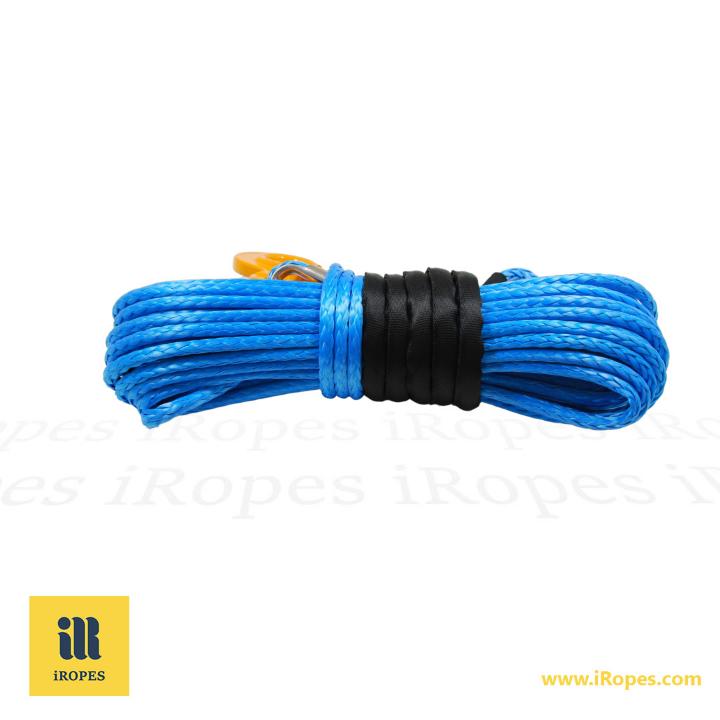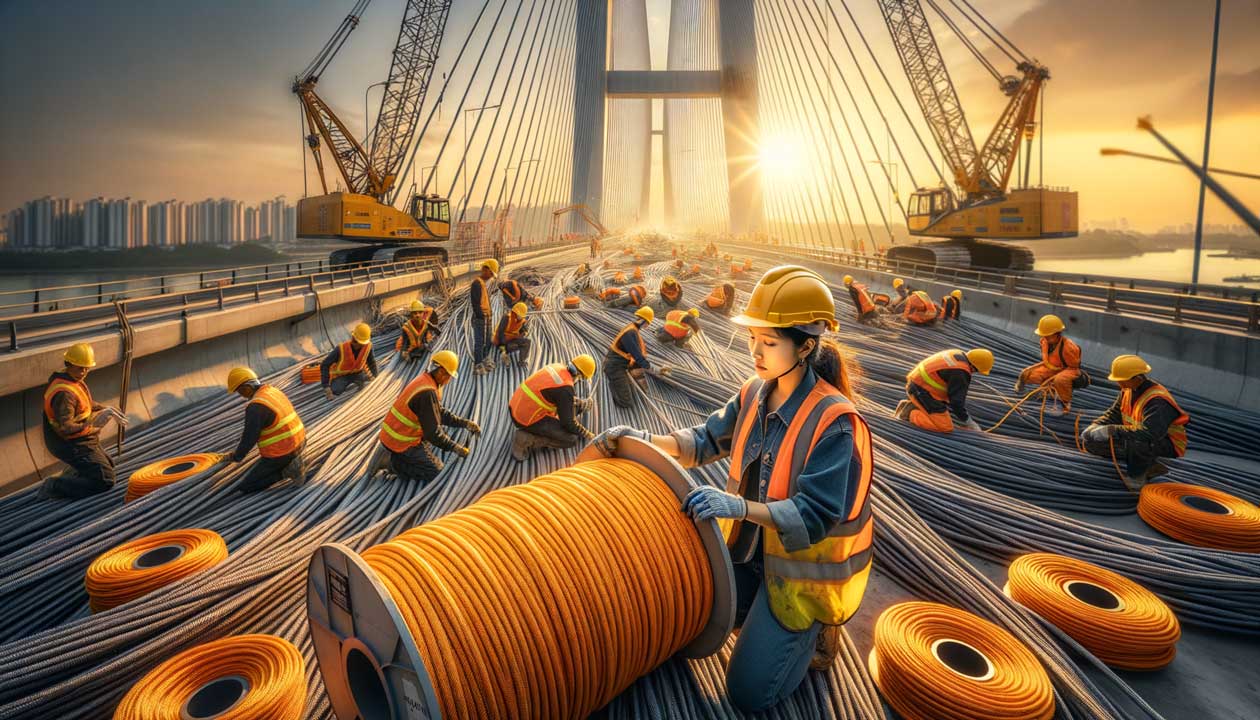In the world of ropes, there's a battle brewing – a clash between the traditional and the modern. On one side, we have the tried-and-true steel cables, rugged and reliable. On the other, the sleek and lightweight synthetic ropes, touting their own set of advantages. At the heart of this tug-of-war lies a simple question: which material reigns supreme?
As someone who has spent countless hours navigating treacherous terrain, scaling towering cliffs, and braving the elements, I know firsthand the importance of choosing the right rope. It's not just a matter of strength and durability; it's about finding the perfect balance of safety, flexibility, and performance.
When it comes to synthetic ropes, their sheer versatility and innovative properties make them worthy adversaries to the age-old dominance of steel cables. Crafted from advanced materials like UHMWPE , these lightweight marvels boast an impressive strength-to-weight ratio that puts their predecessors to shame. But that's just the beginning.
Synthetic ropes aren't merely a substitute for their steel counterparts; they're a revolution in themselves. With their exceptional resistance to abrasion and the elements, synthetic ropes have raised the bar for durability. Meanwhile, their smooth surface and easy handling ensure a level of safety and efficiency that steel cables can only envy.
So, whether you're an avid climber, a marine enthusiast, or simply someone who appreciates the finer things in life, let me invite you to embark on a journey through the world of synthetic ropes. Prepare to be amazed by their versatility, their resilience, and their unwavering ability to outshine even the most stubborn of steel cables.
Advantages of Synthetic Winch Rope Over Steel Cable
Have you ever found yourself debating between synthetic rope and steel cable for your winch setup? As an avid off-roader, I've had my fair share of experiences with both materials. Let me tell you, once I made the switch to synthetic winch rope, I never looked back! In this section, we'll dive into the key advantages that make synthetic rope a clear winner over traditional steel cable.
Synthetic winch ropes, made from materials like UHMWPE , offer a range of benefits that simply can't be matched by their steel counterparts. These advanced materials have revolutionized the winching industry, providing enhanced safety, superior strength-to-weight ratios, and improved handling characteristics.
Safety Benefits of Synthetic Winch Rope
Picture this: you're out on the trail, and your winch cable snaps under heavy load. With a steel cable, you're facing a potentially dangerous situation with a heavy, whipping cable that can cause serious injury. However, with a synthetic rope, the risk is significantly reduced. Synthetic ropes store less energy than steel cables, meaning if they do break, they're less likely to cause harm.
Another safety advantage of synthetic ropes is the absence of burrs and rough edges. Have you ever tried handling a steel cable without gloves? It's a recipe for cuts and abrasions. Synthetic ropes, on the other hand, are smooth and easy to handle, reducing the risk of injury during winching operations.
Lightweight Design
Reduced weight for improved vehicle performance
• SS tube thimble+1.5M sleeve, end with lug.
MATERIAL: UHMWPE
CONSTRUCT: 12-Strands
ELONGATION: 4.80%
Strength and Weight Advantages of Synthetic Rope
Now, let's talk numbers. Did you know that synthetic ropes can have breaking strengths 30-90% higher than steel cables of the same diameter? That's right, these lightweight ropes pack a serious punch when it comes to strength. In fact, synthetic winch ropes are up to 80% lighter than their steel counterparts, which can make a significant difference in your vehicle's overall weight and performance.
The reduced weight of synthetic ropes not only improves fuel efficiency but also enhances the maneuverability and handling of your vehicle. When you're navigating tough terrain, every pound counts. By opting for a lightweight synthetic winch rope, you're giving yourself a competitive edge on the trails.
Moreover, synthetic ropes are incredibly resistant to abrasion, ensuring long-lasting performance even in harsh conditions. Unlike steel cables, which can kink and develop weak spots over time, synthetic ropes maintain their strength and integrity, providing reliable performance when you need it most.
So, whether you're a seasoned off-road enthusiast or just starting your adventures, upgrading to a synthetic winch rope is a decision you won't regret. With unmatched safety benefits, impressive strength-to-weight ratios, and improved overall performance, synthetic ropes are the clear choice for modern winching applications.
Understanding the Durability and Longevity of Synthetic Rope
When it comes to choosing the perfect winch rope for your needs, durability and longevity are key factors to consider. You want a rope that can withstand the toughest conditions, perform reliably, and last for years to come. This is where synthetic ropes truly shine, offering superior durability and longevity compared to traditional wire winch cables.
So, what makes synthetic ropes like UHMWPE so durable? It all comes down to their unique properties and resistance to various environmental factors. Unlike wire cables, synthetic ropes are highly resistant to UV exposure, chemicals, and abrasion. This means they can maintain their strength and integrity even when exposed to harsh sunlight, corrosive substances, or rough surfaces.
Factors Affecting Synthetic Rope Lifespan
- UV Exposure: Prolonged exposure to ultraviolet rays can degrade synthetic fibers over time.
- Chemicals: Exposure to harsh chemicals can weaken the rope's structure and compromise its strength.
- Abrasion: Friction against rough surfaces can cause wear and tear on the rope fibers.
- Usage Frequency: The more frequently a rope is used under load, the faster it may wear out.
- Maintenance: Proper care and maintenance can significantly extend the lifespan of synthetic ropes.
Proper Maintenance for Longer-Lasting Synthetic Ropes
To ensure your synthetic winch rope lasts as long as possible, proper maintenance is crucial. Here are some tips to keep your rope in top condition:
- Regular Inspections: Inspect your rope before and after each use for signs of wear, damage, or fraying. Address any issues promptly to prevent further deterioration.
- Cleaning: Rinse your rope with fresh water after use, especially if exposed to mud, dirt, or salt water. Allow it to air dry completely before storing.
- Storage: Store your synthetic rope in a cool, dry place away from direct sunlight and chemicals. Avoid storing it under tension or with knots, as this can cause deformation.
- Proper Spooling: When spooling your rope back onto the winch drum, ensure even and tight wraps to prevent tangling or uneven wear.
- Timely Replacement: Despite their durability, synthetic ropes will eventually wear out. Keep track of the rope's age and usage, and replace it when signs of excessive wear or damage are present.
By following these maintenance best practices, you can significantly extend the lifespan of your synthetic winch rope, ensuring reliable performance and safety for years to come.
So, how long can you expect a well-maintained synthetic rope to last? While lifespans can vary depending on usage and conditions, a high-quality synthetic winch rope can provide up to 10 years of service with proper care. That's a testament to the incredible durability and longevity these advanced materials offer.
In contrast, wire winch cables are more susceptible to kinking, fraying, and developing sharp edges over time. These issues not only compromise the cable's strength but also pose safety risks during handling. Synthetic ropes eliminate these concerns, providing a safer and more reliable winching experience.
When you invest in a synthetic winch rope, you're not just getting a strong and lightweight alternative to wire cable; you're getting a long-lasting, durable solution that can withstand the toughest challenges. With proper maintenance and care, your synthetic rope will be a trusty companion on all your adventures, delivering the performance and reliability you need when it matters most.
Versatility and Applications of Synthetic Ropes
Picture this: you're on a boat, cruising through crystal-clear waters, and you notice the ropes holding everything together. They're not the heavy, cumbersome steel cables you might expect, but rather sleek and lightweight synthetic ropes. The same goes for the rigging on the sails and even the fishing nets. But the versatility of synthetic ropes extends far beyond marine applications.
As an engineer with years of experience across various industries, I've seen firsthand how synthetic ropes have revolutionized the way we work. From construction sites to offshore oil rigs, these high-performance materials are making a significant impact. So, let's dive into the world of synthetic ropes and explore their incredibly diverse range of applications!
Synthetic Rope in Marine and Outdoor Activities
If you're an avid boater, sailor, or fishing enthusiast, you know that having reliable and durable ropes is essential. Synthetic ropes, such as nylon, polyester, and polypropylene, have become the go-to choice for many marine applications. Their resistance to water, UV rays, and abrasion makes them ideal for use in harsh marine environments.
Imagine you're out on a fishing trip, and you need to secure your boat to the dock. With a synthetic mooring rope, you can have peace of mind knowing that it won't deteriorate or weaken due to constant exposure to water and sunlight. The same goes for rigging on sailboats, where lightweight and strong synthetic ropes allow for smooth and efficient operation.It Its classic design and pleasant-to-touch highly UV resistant cover are the
main characterizing features of this all round rope for cruising yachts.
MATERIAL: polyester-polyester
CONSTRUCT: 8 /16x3
ELONGATION: 15%
- Mooring and docking lines
- Sailboat rigging and sheets
- Fishing nets and lines
But the benefits of synthetic ropes extend beyond just marine activities. They're also widely used in various outdoor pursuits, such as climbing, camping, and off-roading. The lightweight and flexible nature of synthetic ropes makes them easy to handle and transport, while their strength and durability ensure reliable performance in demanding situations.
Construction and Engineering Uses of Synthetic Rope
Now, let's shift gears and explore the crucial role synthetic ropes play in the construction and engineering sectors. Have you ever looked up at a towering crane and wondered how they manage to lift such heavy loads? The answer lies in the use of high-performance synthetic ropes.
Synthetic ropes, particularly those made from materials like UHMWPE (Ultra-High Molecular Weight Polyethylene), offer an exceptional strength-to-weight ratio. This means they can handle immense loads without adding excessive weight to the lifting equipment. In construction, synthetic ropes are used for hoisting materials, securing scaffolding, and ensuring worker safety through fall protection systems.
- Hoisting and lifting heavy loads in construction and industrial applications.
- Securing scaffolding and providing fall protection for workers.
- Mooring and towing in offshore oil and gas operations.
The oil and gas industry also relies heavily on synthetic ropes for various applications, such as mooring and towing of offshore platforms and vessels. The superior strength, low stretch, and abrasion resistance of synthetic ropes make them ideal for these demanding environments. Click here to explore more about the superior features of our 12-strand winch rope.
It's not just about brute strength, though. Synthetic ropes also offer excellent flexibility and easy handling, making them convenient for workers to use on construction sites. They can be easily spliced, terminated, and customized to suit specific requirements, whether it's adding protective sleeves or creating specialized lifting configurations. For more details on customizing ropes, check out our guide to rope customization.
So, the next time you see a towering crane or an offshore platform, remember that synthetic ropes are playing a crucial role in ensuring safe and efficient operations. These versatile materials have transformed the way we build and engineer, offering unparalleled performance and reliability in the most demanding applications.
In conclusion, the versatility and diverse applications of synthetic ropes are truly remarkable. From the depths of the ocean to the heights of construction cranes, these innovative materials are making a significant impact across various industries. As technology continues to advance, we can expect to see even more exciting developments in the world of synthetic ropes, pushing the boundaries of what's possible in terms of strength, durability, and performance.
Comparing Market Trends and Adoption Rates
As someone who's been in the winching industry for over a decade, I've seen firsthand how market trends and adoption rates can make or break a product's success. When it comes to synthetic ropes versus wire winch cables, the shift in consumer preferences is undeniable. But what's driving this change, and how can businesses stay ahead of the curve? Let's take a closer look at the market forces shaping the future of winching.
The Innovation Adoption Curve
To understand how new products like synthetic ropes gain traction in the market, we need to look at the innovation adoption curve, also known as the technology adoption lifecycle. This model breaks down the process of how a new innovation spreads through different customer segments over time.
Here's a quick rundown of the five key segments:
- Innovators: The first 2.5% to adopt a new product, these tech-savvy risk-takers are eager to try cutting-edge innovations.
- Early Adopters: The next 13.5%, early adopters are opinion leaders who embrace new technologies and influence others to follow suit.
- Early Majority: Making up 34% of the market, the early majority are pragmatic consumers who adopt new products once they've proven their value.
- Late Majority: Another 34%, the late majority are more conservative and risk-averse, waiting until a product is well-established before making the switch.
- Laggards: The final 16%, laggards are traditionalists who are resistant to change and may never adopt a new product.
By understanding where synthetic ropes fall on this curve and which segments are driving adoption, businesses can tailor their strategies to capitalize on the growing demand.

Market Adoption Trends and Strategies
So, where does the winching industry stand in terms of synthetic rope adoption? From what I've seen, we're well past the innovator stage and deep into the early adopter and early majority segments, especially in the off-road and recreational markets.
Off-road enthusiasts and adventurers were among the first to recognize the benefits of synthetic ropes, such as their lightweight design, superior strength, and improved safety compared to wire cables. As more and more people experienced the advantages firsthand, word spread, and demand skyrocketed.
But the adoption trend isn't limited to just the off-road scene. Synthetic ropes are making significant inroads in industrial and commercial applications as well. Industries like construction, mining, and oil and gas are increasingly turning to synthetic ropes for their durability, resistance to harsh environments, and ease of handling.
To accelerate market adoption and stay competitive, businesses need to focus on strategies that target the right customer segments and showcase the unique value of synthetic ropes. Here are a few key tactics:
- Educate the market: Many consumers may not be aware of the benefits of synthetic ropes or may have misconceptions about their capabilities. By creating informative content, demos, and case studies, businesses can build awareness and trust in the product.
- Leverage influencers: Partnering with respected influencers in the off-road, outdoor, and industrial communities can help spread the word and lend credibility to synthetic ropes.
- Offer trials and demos: Giving potential customers the opportunity to experience the benefits of synthetic ropes firsthand can be a powerful way to drive adoption and convert skeptics.
- Prioritize customer support: As more users make the switch to synthetic ropes, providing exceptional customer support and resources can help ensure a positive experience and build long-term loyalty.
The future of winching is clear: synthetic ropes are here to stay, and their market share will only continue to grow. By understanding the adoption curve, monitoring market trends, and implementing targeted strategies, businesses can position themselves to thrive in this exciting new era of winching technology. If you're interested in understanding more about the advantages of synthetic ropes, check out our article on why synthetic ropes outperform steel lifting cables.
Discover the Benefits of Synthetic Rope Over Wire Cable
If you're torn between synthetic rope and wire winch cable for your winching needs, consider the distinct advantages of synthetic rope. Not only is it lightweight and easy to handle, but it also boasts a higher breaking strength and superior safety with fewer injury risks. Synthetic ropes resist UV, chemicals, and abrasion, ensuring long-lasting performance without kinking or sharp edges. They are versatile, suitable for various industries, and increasingly preferred in both recreational and industrial markets. As market trends lean towards synthetic ropes, consider switching to this advanced material for enhanced performance and durability. Fill in the form above to learn more about our high-quality, customised rope solutions.